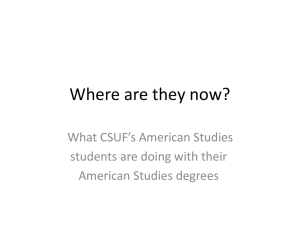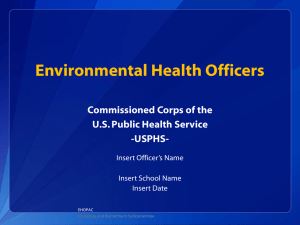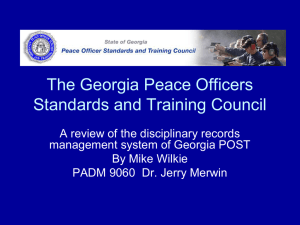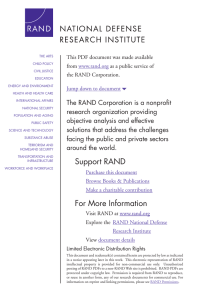RADM Helminiak - Medical Category Issues
advertisement
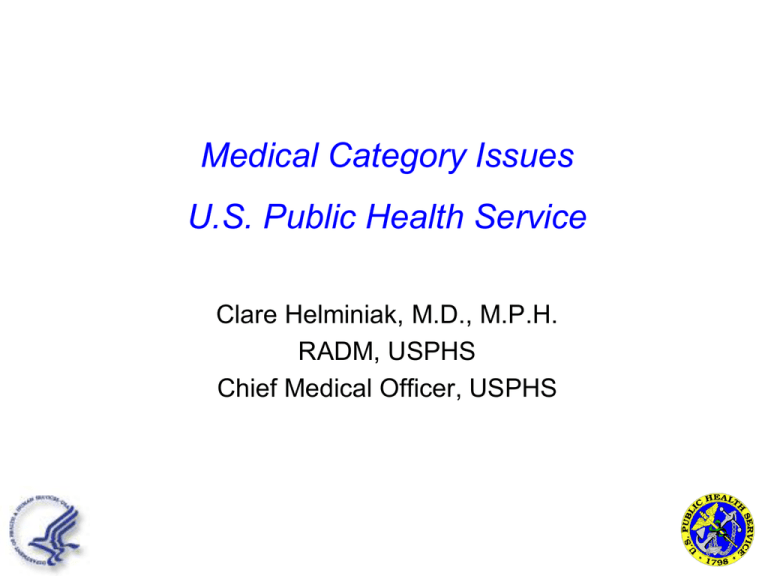
Medical Category Issues U.S. Public Health Service Clare Helminiak, M.D., M.P.H. RADM, USPHS Chief Medical Officer, USPHS Surgeon General’s Priorities • Prevent childhood obesity • Tobacco prevention/cessation • Violence prevention youth mental illness • Medication adherence polypharmacy/the elderly health literacy • Elimination of disparities, especially in the healthcare workforce • Health reform access to care primary care The Corps • Executive Review Group • Conducting review of Corps structures/functions • Policy and operations of the Corps separated into OCCO/OCCFM/PSC in 2003 • Multiple funding streams • Coordination/Accountability issues The Corps (cont.) • Professionalism, Altruism, Patriotism • “If the Nation did not have the Corps we would have to invent it.”—Dr. Koop • “Our conclusion is that the flexibility of the present combination of personnel systems and the difficulties involved in changing it outweigh the advantages of any single system, and that none of the other alternatives can meet the needs of the Service as well as the existing combination of systems do-if these systems are used imaginatively and in concert, so that their potentials are fully realized.” –Folsom Report 1962 The Corps (cont.) • “Never open legislative language unless you absolutely need to…” • The Law of Unintended Consequences….. • Interpretation of legislative language/Congressional intent • “Fix it with regulations” • H.R.3590 - Patient Protection and Affordable Care Act Removed the numerical size cap Reserve officers on active duty became Regular Corps Authorized a Ready Reserve CAD’s, COSTEPS, EIS, etc. The Corps (cont.) • DOD officer confirmations nominations signed by the President subject to confirmation by the Senate Armed Services Committee largely in batch mode - and on a very regular basis • USPHS officer confirmations nominations signed by the President subject to confirmation by the Senate Committee on Health, Education, Labor, and Pensions (HELP) USPHS assimilations approved at most twice a year a streamlined process is needed for USPHS to send appointments to the Senate HELP Committee in a timely manner The Corps (cont.) • Request to OMB for Executive Order • Presidential Delegation of Authority (permanent) for the Secretary to appoint to the Ready Reserve • Paperwork goes to the President for signature • Paperwork goes to the Senate for appointment to the Regular Corp The Corps (cont.) • Current Corps Reserve officers on active duty were “deemed” into the Regular Corps • This served as confirmation by the senate and no further action necessary as the Senate approved the officers by passing the legislation • Orders are needed The Corps (cont.) • An entire set of new regulations needed for Regular Corps and the Ready Reserve • Need an assimilation process for Ready Reserve to become Regular Corps • Need regulations to terminate Regular Corps officers; can’t terminate in the probationary period since all officers are Regular Corps GI Bill Transferability • Request for draft language for the Secretary to review • Attention and interest from HHS to move this forward The Corps (cont.) • Define the domestic and international mission space vision • Support the vision with a strategic and financial plan Formulated in consultation with, and with the support of, the Dept./Agencies DA/OP • OP data can then be accessed and used for multiple purposes to meet officer, agency, personnel, training, and readiness objectives • Officer profiles with primary source validated degrees, registrations, certifications, and licensure (beyond commissionable degree) • DA is the new HR system • Data files shared between OP and DA to create searchable data bases DA/OP • Built-in matching functionality allows identification of right officer at right time for right position • Strategic workforce analysis • Career management/Officer job searches • Agency recruitment • Individual officer’s OP data will be able to be matched directly to position requirements and/or preferences in the new billet system Billets • Needed for effective and efficient force management monitor vacancies identify the best qualified officers monitor skills shortages • Need to reflect the responsibilities of the position, not the individual capabilities Billets (cont.) • For officers clear and specific responsibilities objectively graded billets real time vacancy monitoring career development • For agencies real-time identification of officers for positions electronic referral of candidates Billets (cont.) • Standard component Essential duties Education Training Experience • Position specific components Detail of duties Geographics Additional qualifications Billets (cont.) • Deployment eligibility in the billet not deployment assignment • Only thing specified is the possible deployment eligibility of an officer encumbering a specific billet; deployment assignments made via OFRD Billets (cont.) • Imbedded in the sheet is an automatic and objective system for calculating billet points and grades based upon attribute selections • Not all attributes drive points/grades. • If the billet is downgraded there is a 2 year grace period to avoid adverse effects • CPO’s and PAC’s review billets to confirm compatibility and uniformity Billets (cont.) • Quarantine officer • CMO: applied public health, clinical, mental health, research • Clinician: clinical, mental health • Consultant/advisor: applied public health, clinical, mental health, research • Epidemiologist: applied public health, investigator, research • Manager/planner Billets (cont.) • Inflated billets will be caught by a review process • PAC’s to pick up red flag outliers Physicians by Agency 450 393 400 350 300 250 200 179 150 111 100 76 55 50 0 0 5 1 16 31 0 6 0 12 0 25 1 8 1 0 1 1 Physicians by Temporary Grade 472 229 178 0 0 01 02 23 03 04 05 06 14 7 1 07 08 09 Medical Officers 450 CDC 400 350 Number 300 250 IHS 200 150 100 NIH DHS FDA 50 HRSA 0 1 Agency OS ACF AHRQ AOA ATSDR BOP CDC CIA CMS DHS DOD TMA DOD EPA FDA HRSA IHS INTERIOR NIH OS PSC SAMHSA USAMRMC USDA Top Five Agencies 400 Number of Officers 350 300 99 250 4 200 150 61 12 198 100 73 3 84 4 1 39 94 CDC DHS 17 3 26 15 FDA O6 18+ 99 4 17 61 10 73 O5 18+ 4 1 3 12 0 3 O6 198 39 26 84 14 94 O5 44 25 15 56 4 13 50 44 0 25 56 IHS 10 0 14 4 HRSA 13 NIH Total O5 - O6 Officers/ Officers with 18+ Years Service 300 250 Number of Officers 242 200 150 140 100 107 103 64 50 76 73 41 6 5 3 1 11 3 AHRQ ATSDR BOP Total O5 O6 6 3 Total 18+ 5 1 0 2 2 5 9 2 1 1 20 18 10 17 9 5 2 CDC CMS DHS DoD DOJ FDA IHS HRSA NIH OS PSC 11 242 2 64 9 1 41 140 18 107 17 5 3 103 2 5 2 1 20 73 10 76 9 2 Total O5 - O6 Officers/ Officers with 25+ Years Service 300 250 Number of Officers 242 200 150 140 100 107 64 50 41 15 17 2 0 5 9 1 1 0 3 18 3 6 1 3 0 11 0 AHRQ ATSDR BOP CDC CMS DHS DoD DOJ FDA IHS HRSA Total O5 O6 6 3 11 242 2 64 9 1 41 140 Total 25 + 1 0 0 15 0 5 1 0 3 17 0 10 17 1 5 0 NIH OS PSC 18 107 17 5 3 10 1 0 Recruitment Resources vs. Resourcefulness •Strategic qualitative and quantitative plan and funding Centrally fund USUHS students Centrally fund COSTEP programs Sponsor residents in training Expanded central and field recruiters Every officer a recruiter Placement of senior officers in academia, S/L/T/T high visibility billets, etc. •Strategic partnership with Dept./Agency leadership/HR with tailored recruitment goals and job matching/assignment counseling Recruitment • Associate Recruiter program • “Corps-centric” • #2 Associate Recruiter leads based on the 10 HHS regions and defined # of associate recruiters 10(?) Selected by DCCR • 5-7 hours per month • Attend recruitment events in their area • Provide applicant follow-up Assignments • CAM teams process application packets for Boards • Need to collaborate with hiring officials • Match qualified applicants to vacancies • Robust assignments system • eCAD, starting with pharmacy and engineer Retention •Coherent and funded framework for officer development/training/career paths Loss of specials pays during training •Rotational year in all Depts./Agencies •Every officer a recruiter Spirit of volunteerism No staff, no funding •Placement of senior officers in academia, S/L/T/T high visibility billets, etc. Physician Pilot • 14 physicians brought into the PHS • Majority of physicians are coming through the “senior physician” route even if they are prior service, since most are eligible for 0-5; even more likely in the future since all officers will be Regular Corps and this was one of the draws of the interservice transfer route • Only one officer was brought in as 0-4 through the program Physician Pilot • Offer commissions to a limited number (35 per year) of qualified senior civilian physicians such they are able to enter the Corps at the 0-5 rank (currently medical officers can’t be commissioned for extended active duty at ranks higher than 04). This would require the removal of current limitations on calculating creditable Training and Experience. • Waive the 8 year prior military service cap (up to 15 years) as long as the candidate commits to 10 years of active-duty service in the Corps(automatic for qualified candidates rather than through the submission of individual waiver requests) • Candidates with more than 15 years of prior military service will be considered after the receipt of an appropriate waiver request. Physician Pilot • targeted blanket waivers of the 44-year age limitation for accession of medical officers (currently, waivers to the 44-year age limitation are granted only on a case by case basis) • allow the accession of medical officers on unlimited tours of active duty, and on 3-year limited tours of active duty • Unlimited Tours of Active Duty-a blanket waiver of the 44-year age limitation for physicians who are Board certified • 3-Year Limited Tour of Active Duty: for officers who do not quality for the blanket waiver described in institute a blanket age waiver of the 44-year age limitation for physicians who are Board certified or Board eligible Physician Pilot • family medicine, internal medicine, pediatrics, geriatrics, obstetrics/gynecology, general surgery, psychiatry, child psychiatry, preventive medicine and infectious disease (adult or pediatric) • automatic for physicians who are Board certified in the above specialties whose ages are greater than 44 but less than 51 years, rather than through the submission of the individual waiver requests • regardless of specialty, candidates aged 51 or greater will be considered for accession to unlimited tours of active duty after the receipt of appropriate waiver requests Readiness • 54 physician responses to email regarding their lack of readiness 6 indifferent/retiring 6 IT issues 6 busy 6 angry 13 working on it 5 identified a problem and couldn’t get assistance 3 injury/illness 3 can’t figure readiness out 6 OCONUS

